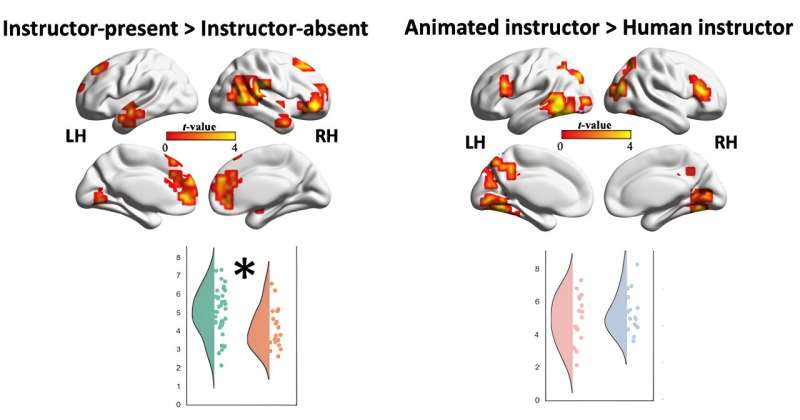This article has been reviewed according to Science X's editorial process and policies. Editors have highlighted the following attributes while ensuring the content's credibility:
fact-checked
peer-reviewed publication
trusted source
proofread
Research reveals significant effects of onscreen instructors during video classes in aiding student learning

Online learning has become "the new normal" of education since COVID-19 severely disrupted face-to-face teaching activities. Researchers from The Hong Kong Polytechnic University (PolyU) have conducted a study to analyze whether and how the instructor's presence in online video lectures affected student learning and learning outcomes.
The results reveal that students are more motivated to perform socio-emotional and cognitive processing when an instructor, human or animated, is present onscreen, hence facilitating more effective learning. The study findings have been published in the journal Proceedings of the National Academy of Sciences.
Previous studies have indicated that socio-emotional cues, such as human facial expressions and gestures, help students understand and stay focused on learning content. Led by Prof. Ping LI, Dean of the Faculty of Humanities and Sin Wai Kin Foundation Professor in Humanities and Technology at PolyU, the research team studied how learners respond to virtual learning with different types and levels of interaction by examining multimodal data of students' learning performance, brain activity and eye movement, as well as the correlation between these measurements.
Participating in the experiment were 81 PolyU students—some of them watched video lectures with a human instructor accompanying the lecture slides, some watched the same video lectures with an animated instructor, and some watched the lectures with no onscreen instructor and only the lecture slides. This was followed by a set of assessments of how effectively they had learned.
Compared with the no-instructor group, students with an onscreen instructor performed significantly better in the post-course assessments, while the exact embodiment of the instructor—real vs. animated—did not affect the overall scores. The results provide strong and important evidence that the instructor's image, human or animated, improves educational outcomes in the virtual setting.
The researchers examined the impact of instructor's image on learning through a combination of functional magnetic resonance imaging (fMRI) and eye-movement tracking of the students as they watched the lectures. While students with an instructor performed better, the eye-tracking results, surprisingly, showed that the human instructor may actually distract the students from the slides, as more time was spent by students looking at the slides when the instructor was absent or was an animation.
A deeper analysis of the eye-tracking data resolved this contradiction. Crucially, the correlation of eye movements—the extent to which the students shifted their gaze in unison—was higher in instructor-present groups than in the no-instructor group, and better-performing students also displayed more correlated eye movements than the lower performers.
This suggests that although an instructor's image may distract students from the slides, it is also more likely in guiding them to pay attention to the appropriate parts of the onscreen content. In other words, students with an instructor tend to focus on the same places, while those without an instructor are more random in their focus.
The fMRI results, which identified the specific brain regions students used most, aligned with the eye-tracking data. Just as their eye movements were synchronized, so did the students with an instructor show greater synchrony in the activity of brain regions crucial for learning, including regions involved in working memory and mentalizing.
This alignment can be attributed to the higher level of cognitive and socio-emotional processing motivated by the onscreen instructor that served as a social cue. Under this condition, learners follow the visual content in the video more closely, allocate attention more proactively and ultimately learn better.
As the data suggest that an onscreen instructor's image entails both socio-emotional benefits and attentional distraction unrelated to learning, the researchers further propose a trade-off hypothesis suggesting learning outcome depends on whether the benefits can outweigh the costs brought by the distraction.
While the trade-off also relies on a learner's ability to leverage socio-emotional processing and attention control for learning, it explains the individual difference in student learning under the same virtual setting.
Prof. Li said, "Although the pandemic has subsided, online learning through the use of multimedia instructional videos continues to shape education. Our findings suggest that an onscreen instructor—even an animated one—can make up for some deficits of the online learning setting, where socio-emotional cues are less salient and cognitive engagement is harder to sustain.
"This contributes to the development of an evidence-based instructional design for multimedia learning, thereby enhancing student's learning experience and outcome."
More information: Chanyuan Gu et al, Onscreen presence of instructors in video lectures affects learners' neural synchrony and visual attention during multimedia learning, Proceedings of the National Academy of Sciences (2024). DOI: 10.1073/pnas.2309054121
Journal information: Proceedings of the National Academy of Sciences
Provided by Hong Kong Polytechnic University





















